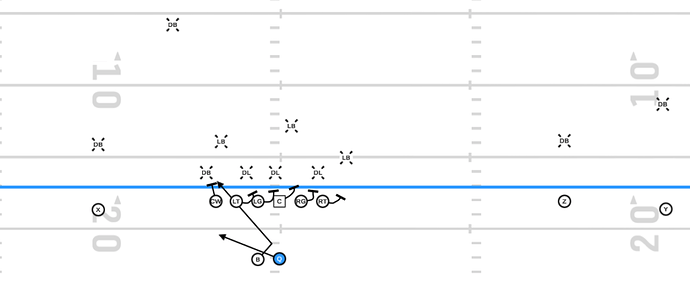By Dustin Ragusa
Yesterday in part one of my three-part offensive film review of the Baylor game, I took a look at the overall scheme. Today, I’ll dive into the Cowboy running game.
Rushing Attack
Richardson’s Zone Success
As a reminder, the terms Inside Zone and Outside Zone refer to blocking schemes that have the offensive linemen blocking specific gaps instead of a certain defender. If an O-lineman has a defender lined up in front of him, he blocks him. If he doesn’t have a defender lined up in front of him, then he steps toward the side the play is going and either helps double-team block a defender or moves to the second level (think linebackers or safeties playing up near the line of scrimmage).
One of the ways the Cowboys found success on their zone runs against BU was with a “cap” blocker. This is a play I wrote about from the Texas Tech game, and we saw it work well again in this one. With “cap,” the Cowboy back will block the edge defender on the Cowboy back’s side of the formation, normally the linebacker in Baylor’s defensive scheme. See the example below.
Next, we see another Outside Zone run, but this time there’s a Cowboy back on each side of the line of scrimmage. You can see left guard Hunter Woodard (No. 70) do a nice job of leaving his double-team block on the defensive lineman and getting in the way of the BU linebacker, opening up a running lane. Richardson makes a nice cut, keeps his legs driving after contact and has another solid gain.
Here we see an Inside Zone blocking scheme with the Cowboy back in the H-back spot. Richardson is able to bounce this one outside as he sees the defense is congested in the middle of the field, and it was the right decision as he picks up a huge gain.
The last play I wanted to point out in this section is one the Pokes ran out of the 13-personnel Diamond formation I discussed in Part 1 of this film study. In the video below, you’ll see another zone run, this time it’s Insert Iso. The Cowboy back on the right side of the diamond inserts into the gap between the right tackle and the Cowboy back on the line of scrimmage.
Along with Richardson, Dezmon Jackson and Micah Cooper had some nice runs out of the zone blocking scheme as well.
Power
Outside of zone, the Cowboys also went with Power, which has been another recent staple of the OSU rushing attack. The Power blocking scheme normally involves a lineman pulling around to the play side to lead block through the hole. This is different from a zone run in that the offense’s point of attack is predetermined.
Oklahoma State scored two of its three rushing TDs on the day with Power. In the first clip below we see the Cowboys lined up in 13 personnel, with two Cowboy backs on the line of scrimmage to the right and the third Cowboy back lined up as the fullback in an I-formation. In addition, they have an extra tackle on the left side of the line and no wide receivers on the field. The backside guard (No. 74 Preston Wilson) pulls around to the playside and lead blocks through the hole. The front side of the line, including the Cowboy back, blocks down, or away from the playside.

Next, we see the Cowboys score on the same play later in the game.
We also saw the Pokes run Power out of an 11 personnel, shotgun formation, as you’ll see below.
The Rest of the Rushing Attack
Offensive coordinator Kasey Dunn primarily went with Zone and Power in this one. There were a few designed quarterback runs, like this QB draw shown below.
The QB keep on fourth down shown in the following video.
And, the Zone Bluff play we discussed last week in the TCU film review.
The remainder of quarterback Spencer Sander rushing yards came from scrambling. Additionally, there was the Jelani Woods rush I mentioned yesterday, but really it was mainly Zone and Power.
The OSU offensive line played a solid game, and the Cowboy backfield did the rest. It was a nice end to the regular season for the Oklahoma State rushing attack.
